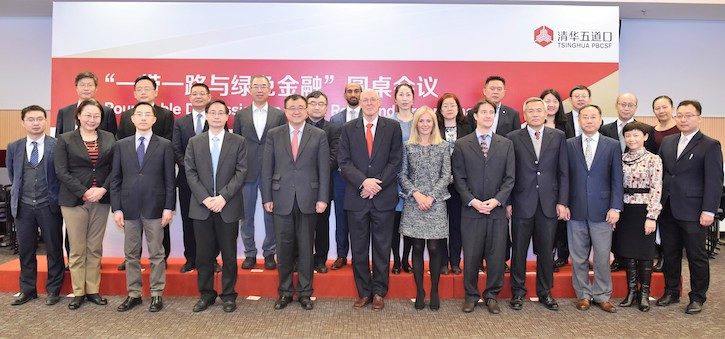
As China develops its Belt & Road Initiative (BRI), the promotion of green finance will be one of the priorities. It carries such weight that it was specifically mentioned as part of President Xi’s report to 19th Communist Party Congress. The Belt & Road Initiative encompasses 65 countries with a potential demand for infrastructure financing from $1 – $1.6 trillion per year. It is certainly an opportunity for China to take a leadership role in greening the Belt & Road and “exporting” its green finance standards.
On November 1st, the Paulson Institute (PI) co-hosted a “Roundtable Discussion on Belt & Road and Green Finance” attended by over 30 senior officials and experts from government agencies, commercial banks, international financial institutions, international organizations and NGOs. Henry M. Paulson Jr., Chairman of the Paulson Institute and Yang Bin, Vice President of Tsinghua University made keynote remarks at the Roundtable. The discussions were moderated by Deborah Lehr, Vice Chairman of the Paulson Institute and Ma Jun, and Director of the Center for Finance and Development at Tsinghua University.
This meeting is part of a series of high-level roundtable discussions on green finance with our Chinese partner–the Center for Finance and Development of Tsinghua National Institute of Financial Research. It is also the first event since Ma Jun’s transition to Director of the newly established Center. He is the former Chief Economist at the Research Bureau of the People’s Bank of China (PBOC), and now serves as a special advisor to PBOC Governor and also Director of Green Finance Committee of China Society for Finance and Banking.
China’s direct investment in the Belt & Road region was about $15 billion in 2016, but there is a much larger demand from BRI countries for infrastructure financing. It is impossible for China to fulfill this demand alone. International financial institutions that manage over $100 trillion in assets can and should fill this gap. This private sector capital is essential to the success of BRI infrastructure financing – as well as green development along the Belt & Road – and will require the development of attractive and innovative financing instruments.
The PI/Tsinghua program explored this particular issue—how to focus on improving the “greenness” of investment in the BRI and how to develop policies and practices to mobilize international capital for investment in Belt & Road countries.
A number of key issues emerged from the discussions:
- No common standard on defining green: There is currently a broad range of definitions for “green,” even among institutions in China. As the driver of the BRI and an emerging global leader in green finance, China plays a significant role in developing a universal definition for green investment and the high quality international standards that will help guide all interested investors.
- Lack of regulatory policies on green investment: Without a clear regulatory structure, it is difficult to have a common understanding of green development. Therefore, it is important to develop and enforce a set of regulatory policies to provide guidance and incentives that encourage both domestic and international investors for infrastructure investment in the BRI. Environmental risk disclosure should also be included in these policies.
- Political risk: Many BRI countries are high-risk investment targets, often due to political instability. As infrastructure projects tend to be long-term investments, there is a need for the development of political risk insurance.
- Foreign exchange risk: While foreign exchange hedging instruments do exist, they are not often available for BRI projects or countries. There is a great need to develop these types of instruments as these infrastructure investments tend to be long term and in high-risk countries, which subject them to greater foreign exchange fluctuations. Foreign exchange changes can significantly influence investment returns in the instances where there are minimal project yields.
- Information asymmetry and transparency: As these mega infrastructure projects involve a significant number of firms, there is often information asymmetry between the governments, construction firms, financial institutions and other participants. In addition, there are a variety of standards to be met depending on the country where the project is located. This lack of information makes it more complicated for investors who prefer clear data and transparency.
- Political will: Many of the countries along the B&R are high risk politically. It is important to ensure that the political will exists at the highest level to support these infrastructure projects and green development.
- Develop toolkits and capacity building: Toolkits can help guide investment in the green sectors, including helping companies better understand global corporate governance standards, government systems, and help unify project standards. Financial institutions are better able to evaluate and manage risk with greater understanding and transparency. There is an urgency to develop the toolkits for project implementation as well as risk evaluation and management of BRI investments, in order to facilitate engagement of financial institutions, enterprises and NGOs.
At the conclusion of the meeting, the participants agreed to establish a joint study group, led by the Center for Finance and Development of Tsinghua National Institute of Financial Research and joined by the Paulson Institute, to develop a set of voluntary principles for green finance along the BRI. In addition, the Paulson Institute is working with leading experts to draft a series of policy studies to outline the challenges of green Belt & Road investment identified at the Roundtable. As China’s BRI has the potential of promoting green development across a broad range of countries, it is essential that high quality standards and principles are developed. The Paulson Institute is pleased to be part of this effort.



